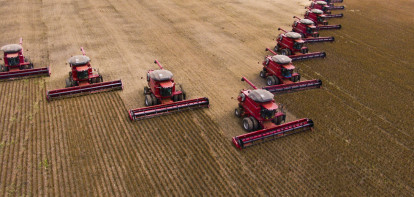Analysis Grains
Rain continues to challenge French grain farmers
Rain or the lack thereof remains a theme in the grain market. In France, precipitation continues to cause issues for farmers. Whether it's during the harvest of corn or the sowing of winter grain. In South America, farmers could actually use rain after a very dry and warm period. Russia announced measures last Friday to restrict grain exports. However, the latest figures do not reflect this.
The December contract for wheat on the Matif closed €0.25 lower at €228.75 per ton yesterday. Wheat on the CBoT fell more significantly, closing 2.1% lower at $5.86½ per bushel. Corn also closed in the red, dropping 1.9% to end at $4.07¾ per bushel. Soybeans closed 0.9% lower at $9.96 per bushel.
The wet weather is not over for this season. In France, as of October 7, only 6% of the corn acreage had been harvested, according to FranceAgriMer data. Last year at this time, half of the corn had been threshed. Since 2013, the corn harvest in France has not started so slowly. Not only is the harvest affected by the wet conditions, but the sowing of winter barley and wheat is also behind the five-year average according to FranceAgriMer.
Export Duty
In Russia, there are concerns about sufficient wheat supply. Last Friday, the Kremlin held discussions with Russian grain exporters on limiting grain exports. The main outcomes include the Russian ministry increasing the export tax on wheat by 42% to 1,872 rubles per ton. This is equivalent to €17.80 per ton. Additionally, the ministry sets a minimum bid price in tenders at $250 per ton delivered on the ship and aims for direct dealings with buyers without third parties.
The Russian efforts to slow down grain exports are not yet reflected in the figures. SovEcon reports that Russia exported 1.1 million tons of grain last week, of which 1 million tons were wheat. The previous week, Russia exported 870,000 tons of grain, including 800,000 tons of wheat. The price for Russian wheat from Ikar increased by $7 to $230 per ton FOB. The price is on the rise but has not reached the ministry's desired level for international tenders of $250 per ton.
Drought in South America
In Argentina, rain has brought some relief. Scattered showers have fallen in the agricultural regions in the north of the country, as reported by the Rosario Exchange. Corn and wheat, in particular, have benefited from this.
In Brazil, soybean planting is not progressing smoothly. Warm and dry weather is hindering the work. According to market agency AgRural, 8.2% of the planned soybean area in Brazil has been planted. Last week it was 4.5%, and last year 17% of the soybeans were planted. Little progress is being made, especially in Mato Grosso. Farmers are waiting for more consistent rain, which is not yet in the weather forecasts. Brazilian farmers are further along with planting the first crop of corn. AgRural reports that 42% of the planned area is planted.




